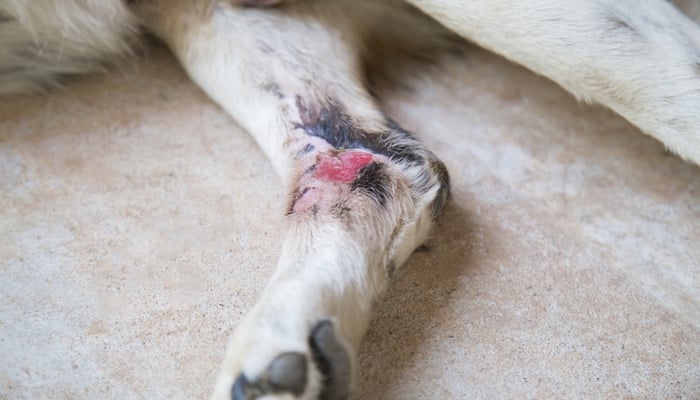All dog owners should know at least a little about canine first aid. If you don't want to have to bring your pet to the veterinarian for every little cut, learning how to treat a dog wound will prove to be invaluable knowledge. If you learn how to clean, bandage, and care for your dog's wounds, you'll save hundreds of dollars on unnecessary vet bills.
Saving money is great, but so is helping your dog. He'll be much more comfortable if you are able to treat his injury at home. Trips to the vet are stressful, especially for an injured dog that is already nervous.
There are a few supplies that you'll need to have on hand when learning how to treat a dog wound. Every pet parent should have a first aid kit for their furry friend. You can purchase pet first aid kits, or you could buy the items separately and make your own.
Either way, there are a few must-have items that every canine first aid kit should include. In order to treat a wound, you'll need:
- hair clippers or scissors
- non-stinging antiseptic solution
- gauze
- antimicrobial ointment
- medical tape or vet wrap
- clean water
- clean cloth
Dogs can get injured as easily as we can. They spend a lot of time outdoors, and they are very naturally curious. This is a bad combination that can lead to a lot of wounds over the course of their lives. This is why it's so important for every pet owner to know how to treat a dog wound.
How To Treat A Dog Wound
 1. When To See A Vet?
1. When To See A Vet?
There are times when you should not clean and treat a dog's wound on your own. If your pet has been bitten by another animal, he needs to see a veterinarian. No matter how minor the injury, your dog MUST see a vet if he's bitten by another animal. He may need vaccinations or other treatments that you aren't aware of.
No matter what the cause, the wound will require stitches if it is deep. The rule of thumb is that if the incision only goes through the skin and the very top layer of flesh, you can feel safe treating it at home. If it goes deeper into the flesh, it's better to have it checked at the vet's office.
You should also seek veterinary attention if the wound is near your dog's eye. A small scratch on your pet's eyeball could lead to an infection in just a few short days. You may not be able to see, and your dog may not even show symptoms of eye irritation at first. There may also be small amounts of debris in his eye that could be very damaging if left alone.
Finally, you'll want to make sure you seek veterinary care if the wound will not stop bleeding after 20 minutes. If your dog's blood isn't clotting within 20 minutes, there may be an underlying issue that his vet will need to address.
2. Clean the Wound
If the wound is bleeding, you'll need to apply pressure until it stops. Using the clean towel, wrap the wound and gently squeeze to apply pressure. The bleeding should stop within about 10 minutes, but remember, if it doesn't stop in 20 minutes you need to call your vet immediately.
It's best to remove the fur from around the wound to make it easier to clean. If you don't have clippers, you can use a pair of scissors or a razor to remove the fur around the wound.
Clippers are the best choice because they virtually eliminate the risk of further injury to your dog. It is very easy to cut your pet with scissors or a razor, so be very careful and go slowly if you're using one of these tools to remove the fur.
Once you've trimmed all the fur around the wound, use the cloth to wipe away loose hair. Now, rinse the wound with clean water until all signs of debris are gone. Pat it dry very gently with the cloth.
SIMILAR: The Ultimate Guide of First Aid for Dogs – 7 Vital Things Every Dog Owner Must Know
 3. Treat the Wound
3. Treat the Wound
Now that you've cleaned the wound, you're going to need to treat it. Apply a non-stinging antiseptic solution. You can also use peroxide to clean the wound. Only clean the wound with peroxide once, because it kills all of the bacteria – even the good bacteria.
Chlorhexidine is another good option. It's affordable and won't sting your pooch when you apply it to his wound. It kills the bacteria and yeast that could cause infection. I recommend leaving a small bottle, like this one, in your pet first aid kit.
After you've applied the antiseptic solution, you'll need to rub on a little antimicrobial ointment. Your dog's natural reaction is going to be to lick the ointment off, so you'll need to sit with him for at least 10 minutes to prevent that.
If you can't keep your dog from licking the wound and irritating it further, you may need to cover it with gauze and medical tape or a bandage. You'll also need to cover the wound if it's in an area that will be easily contaminated, like the paw.
You should clean your dog's wound 2-3 times per day for the first 3 days. After that, clean it once per day until it begins to heal. Check it regularly for signs of infection, as well. If you notice any excessive redness, swelling, or discharge, you need to take your dog to the vet immediately.
READ NEXT: 6 Ways Your Dog Asks for Help












